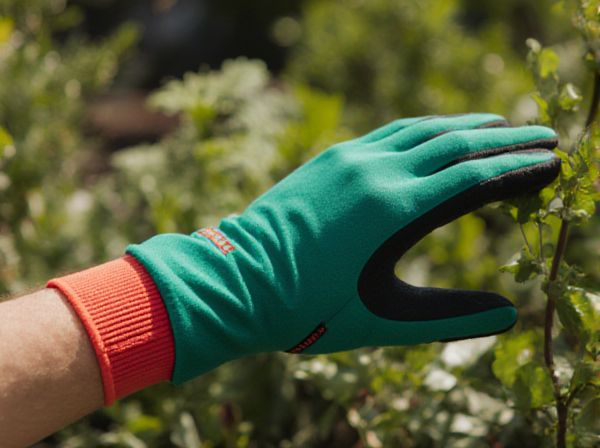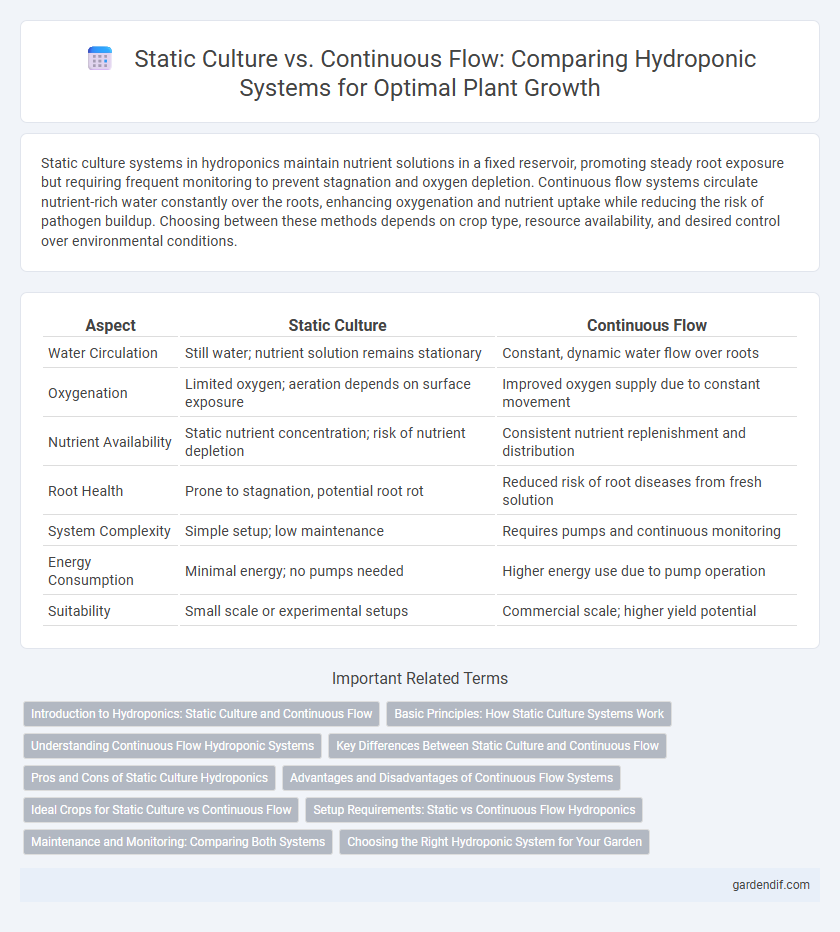
Static Culture vs Continuous Flow Illustration
Static culture systems in hydroponics maintain nutrient solutions in a fixed reservoir, promoting steady root exposure but requiring frequent monitoring to prevent stagnation and oxygen depletion. Continuous flow systems circulate nutrient-rich water constantly over the roots, enhancing oxygenation and nutrient uptake while reducing the risk of pathogen buildup. Choosing between these methods depends on crop type, resource availability, and desired control over environmental conditions.
Table of Comparison
| Aspect | Static Culture | Continuous Flow |
|---|---|---|
| Water Circulation | Still water; nutrient solution remains stationary | Constant, dynamic water flow over roots |
| Oxygenation | Limited oxygen; aeration depends on surface exposure | Improved oxygen supply due to constant movement |
| Nutrient Availability | Static nutrient concentration; risk of nutrient depletion | Consistent nutrient replenishment and distribution |
| Root Health | Prone to stagnation, potential root rot | Reduced risk of root diseases from fresh solution |
| System Complexity | Simple setup; low maintenance | Requires pumps and continuous monitoring |
| Energy Consumption | Minimal energy; no pumps needed | Higher energy use due to pump operation |
| Suitability | Small scale or experimental setups | Commercial scale; higher yield potential |
Introduction to Hydroponics: Static Culture and Continuous Flow
Static culture in hydroponics involves growing plants in a nutrient solution that remains still, allowing roots to absorb nutrients without water movement, which is ideal for simple setups and small-scale cultivation. Continuous flow systems, on the other hand, circulate nutrient-rich water constantly over plant roots, enhancing oxygen availability and nutrient uptake for faster growth and higher yields. Choosing between static culture and continuous flow depends on factors like crop type, system complexity, and resource availability in hydroponic farming.
Basic Principles: How Static Culture Systems Work
Static culture hydroponic systems rely on a nutrient solution that remains stationary within the root zone, allowing plants to absorb nutrients through a balanced, oxygenated medium. This method emphasizes maintaining optimal nutrient concentration and dissolved oxygen levels to prevent stagnation and root rot. Root aeration occurs naturally or through manual oxygenation techniques, supporting healthy plant growth in a controlled environment.
Understanding Continuous Flow Hydroponic Systems
Continuous flow hydroponic systems maintain a constant circulation of nutrient-rich water over plant roots, enhancing oxygen availability and nutrient uptake compared to static culture methods. These systems utilize a pump to deliver a steady flow, which prevents stagnation and supports faster plant growth in crops like lettuce and herbs. The dynamic nutrient delivery in continuous flow systems reduces root diseases and enables precise control of pH and EC levels, optimizing overall plant health and yield.
Key Differences Between Static Culture and Continuous Flow
Static culture in hydroponics involves nutrient solution remaining stagnant around the plant roots, promoting oxygen availability but requiring frequent solution replacement to prevent nutrient depletion. Continuous flow systems circulate nutrient solution constantly, enhancing nutrient uptake and oxygenation while minimizing disease risk through consistent movement. Key differences include nutrient solution dynamics, oxygen levels at the root zone, and system complexity, impacting plant growth efficiency and maintenance needs.
Pros and Cons of Static Culture Hydroponics
Static culture hydroponics offers simplicity and low maintenance, making it ideal for beginners and small-scale growers due to its minimal equipment requirements and ease of setup. However, it poses challenges such as limited oxygen supply to roots and potential nutrient depletion, which can hinder plant growth and yield over time. In contrast to continuous flow systems, static culture may suffer from inconsistent nutrient distribution, necessitating frequent solution changes to maintain optimal plant health.
Advantages and Disadvantages of Continuous Flow Systems
Continuous flow hydroponic systems offer enhanced oxygenation and nutrient distribution, promoting faster plant growth and higher yields compared to static culture. These systems require precise control and monitoring, increasing complexity and initial setup costs, which can challenge beginners. Their continuous nutrient solution circulation reduces the risk of stagnation and root diseases but demands reliable pumps and energy sources to maintain consistent flow.
Ideal Crops for Static Culture vs Continuous Flow
Leafy greens such as lettuce, spinach, and herbs thrive in static culture systems due to their shallow root structures and lower oxygen requirements. Continuous flow systems are ideal for fruiting crops like tomatoes, cucumbers, and peppers, which demand constant nutrient supply and higher oxygen levels for rapid growth. Selecting the appropriate hydroponic method enhances yield and plant health based on the crop's specific nutrient and oxygen needs.
Setup Requirements: Static vs Continuous Flow Hydroponics
Static culture hydroponics requires minimal setup, typically involving a reservoir filled with nutrient solution where plant roots remain submerged without movement, making it suitable for simple, low-maintenance systems. Continuous flow hydroponics demands a more complex setup with pumps and channels to circulate nutrient solution constantly over the roots, ensuring consistent oxygen and nutrient delivery. The choice between static and continuous flow setups depends on factors such as crop type, scale, and available resources, with continuous flow systems generally offering higher growth rates but at increased infrastructure costs.
Maintenance and Monitoring: Comparing Both Systems
Static culture systems in hydroponics require less frequent monitoring but demand careful periodic maintenance to prevent oxygen depletion and nutrient imbalances. Continuous flow systems offer consistent nutrient delivery and oxygenation, reducing nutrient fluctuations but necessitating constant monitoring of pump operation and flow rates to avoid system failures. Both systems benefit from regular pH and EC checks, yet continuous flow setups typically require more vigilant oversight to maintain optimal growing conditions.
Choosing the Right Hydroponic System for Your Garden
Static culture hydroponics relies on nutrient solution remaining still, ideal for small-scale or beginner gardens focusing on low-maintenance growth. Continuous flow systems circulate nutrient solution steadily over plant roots, enhancing oxygen availability and nutrient uptake for faster, more robust plant development. Selecting the right hydroponic system depends on garden size, crop type, and desired growth rate, balancing simplicity in static culture with the efficiency of continuous flow setups.
Static Culture vs Continuous Flow Infographic

 gardendif.com
gardendif.com